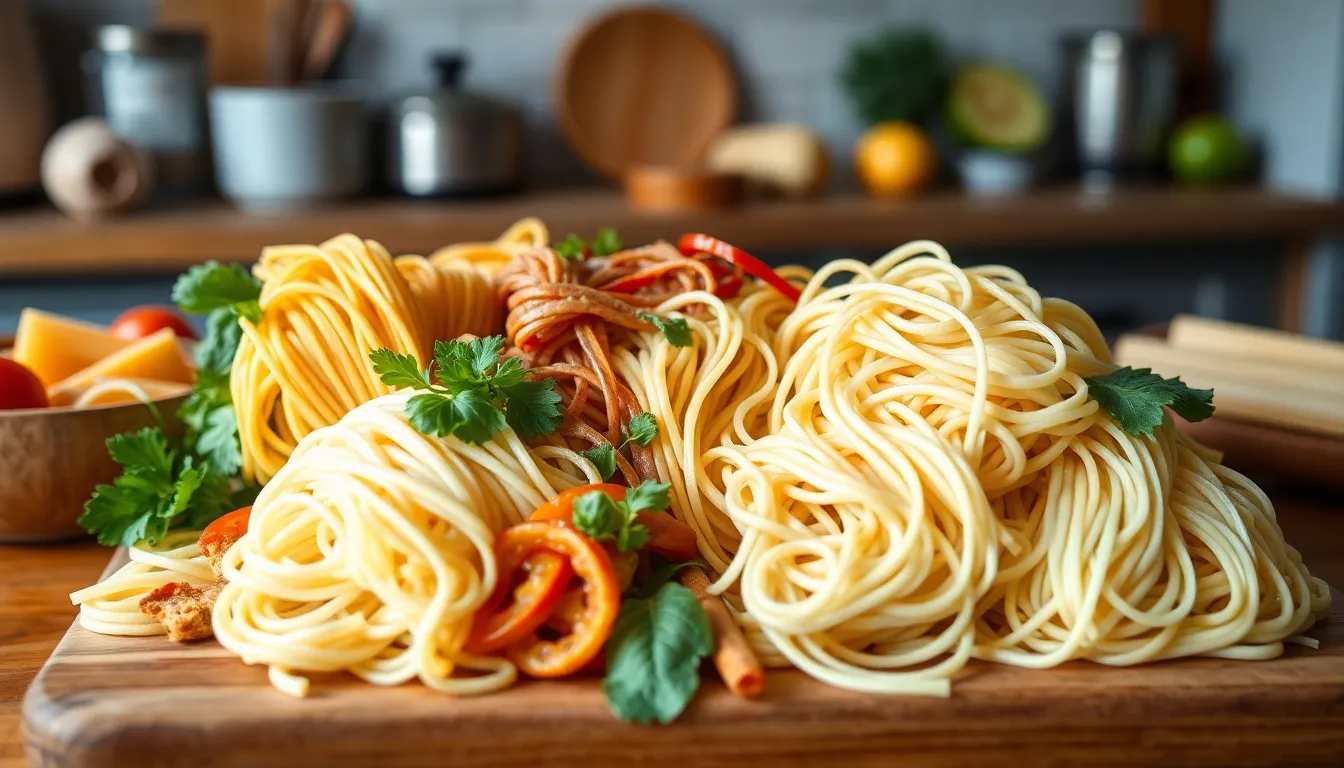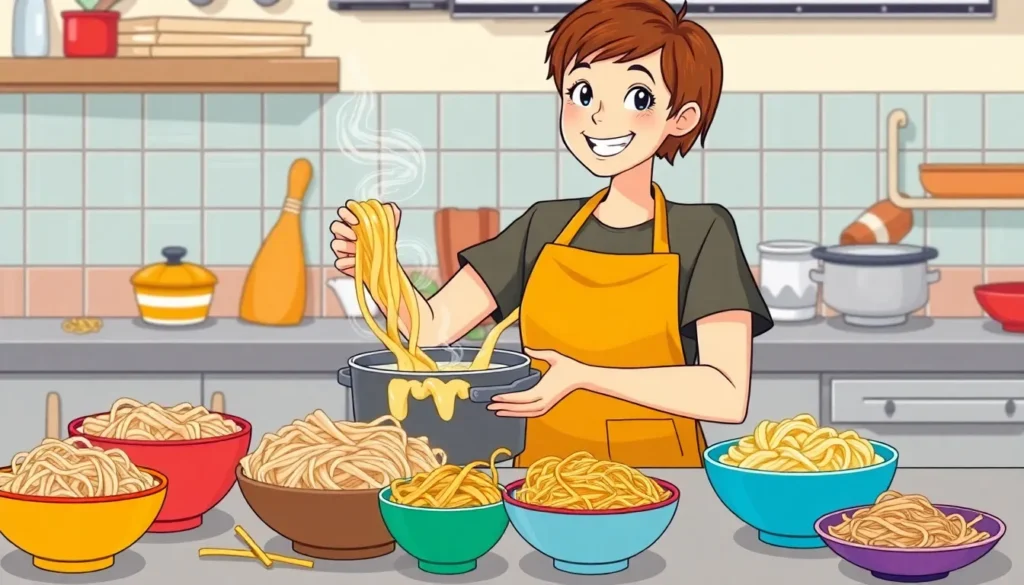When it comes to zavagouda, the right noodles can make or break the dish. Picture this: a creamy, cheesy delight that dances on your taste buds, but wait! What if the noodles are all wrong? Suddenly, it’s a culinary catastrophe instead of a masterpiece. Choosing the right noodles isn’t just a matter of preference; it’s a quest for noodle perfection.
What noodles do you use for zavagouda
Zavaggouda, a rich and creamy dish, relies heavily on the type of noodles used. Selecting the right noodles enhances flavor and texture, contributing to an exceptional culinary experience. Egg noodles deliver a velvety texture, making them an ideal choice. They absorb sauce effectively, creating a harmonious balance in each bite.
Alternatively, wide rice noodles provide a distinct chewiness. This texture complements the smoothness of zavaggouda, offering contrast that excites the palate. Choosing whole wheat noodles introduces a nutty taste, which can elevate the dish further. Their heartiness pairs well with cream-based sauces.
When considering gluten-free options, explore rice or chickpea-based noodles. These noodles maintain a pleasing texture while catering to dietary restrictions. Experimenting with various noodle types often leads to discovering personal favorites in the context of zavaggouda.
Pasta cooked al dente enhances the overall dish significantly. This technique prevents mushiness, ensuring each noodle remains distinct and flavorful. Regularly checking noodle doneness during cooking guarantees optimal texture.
Zavaggouda thrives on creativity. Incorporating unique noodles allows for experimentation, resulting in variations that can surprise and delight. Whether opting for traditional choices or venturing into unconventional territory, the right noodles shape the final dish, defining zavaggouda’s essence.
Types of Noodles for Zavaggouda

Choosing the right noodles is crucial for achieving the perfect zavaggouda. Various noodle types enhance both the flavor and texture of this rich dish.
Common Noodle Varieties
Egg noodles stand out for their smooth texture and sauce absorption. Their creamy consistency often elevates the overall taste of zavaggouda. Wide rice noodles also contribute their unique chewiness, complementing the dish’s richness. Whole wheat noodles introduce a pleasant nuttiness that adds depth. Each variety brings distinctive characteristics, allowing for creativity in flavor combinations.
Specialty Noodles
Gluten-free noodles, such as rice or chickpea-based options, accommodate dietary needs while maintaining a satisfying texture. These specialty noodles ensure that everyone can enjoy zavaggouda without compromising on quality. Additionally, Asian noodle varieties, like udon or soba, provide interesting alternatives that can transform the dish. Experimenting with these noodles may yield delightful new twists on traditional zavaggouda.
Flavor Compatibility
Selecting the right noodles enhances the overall flavor of zavaggouda. Different noodle varieties interact uniquely with the dish’s distinct ingredients.
Pairing Noodles with Ingredients
Egg noodles complement rich sauces and absorb flavors well. Their smooth texture allows for a balanced distribution of zavaggouda’s creamy elements. On the other hand, wide rice noodles add chewiness, creating an enjoyable contrast. Whole wheat noodles introduce a nutty flavor that pairs nicely with savory elements. For those following gluten-free diets, rice or chickpea noodles provide texture without sacrificing taste. Consider the overall dish while choosing noodles to achieve harmony between the noodles and zavaggouda’s creamy sauce.
Cultural Influences on Noodle Selection
Cultural backgrounds impact noodle choices for zavaggouda. In Italian cuisine, using egg noodles aligns with traditional recipes, enhancing authenticity. Asian influences often lead to the selection of udon or soba, both delivering unique textures. The region’s culinary practices shape preferences, as different cultures celebrate various noodle types. In addition, such diversity promotes creativity, allowing cooks to tailor their zavaggouda experience while honoring their heritage.
Cooking Techniques
Cooking techniques greatly influence the final outcome of zavaggouda. Both preparation and cooking steps are vital for achieving noodle perfection.
Preparing Noodles for Zavaggouda
Choose noodles based on personal preference and dietary needs. Egg noodles offer a velvety texture while wide rice noodles provide a satisfying chew. Begin by boiling water; adding salt enhances flavor. Cook noodles according to package instructions, typically between 5 to 10 minutes. Afterward, quickly drain and rinse with cold water to stop the cooking process. This step preserves a firm texture, essential for harmonious integration with creamy zavaggouda.
Tips for Perfectly Cooked Noodles
Consistent timing is crucial when cooking noodles. Test for al dente firmness, which is typically 1 to 2 minutes less than the recommended cooking time. Stir frequently to prevent sticking during the cooking process. Reserve a small amount of cooking water before draining; this can thin out sauces effectively. Combining noodles and zavaggouda sauce shortly after cooking ensures a delightful coating, enhancing overall flavor and texture. Lastly, avoid overcrowding pots to maintain even cooking throughout.
Right noodles for zavaggouda
Choosing the right noodles for zavaggouda is essential for achieving a delicious and satisfying dish. Each noodle type offers unique flavors and textures that can elevate the overall experience. Whether opting for egg noodles, wide rice noodles, or gluten-free alternatives, the key lies in personal preference and creativity.
Cooking techniques also play a vital role in ensuring the noodles maintain their ideal texture. By following the recommended cooking steps and experimenting with various noodle options, anyone can create a memorable zavaggouda that delights the palate. Embracing this culinary journey will not only enhance the dish but also honor the diverse influences that shape it.
